the Quadrangle

ManhattanUniversityPerformingArts DepartmentUnveilsNewMural
MultipleperformingartsgroupsatMUperformedincelebrationofthenewmural paintedbyalumnaMadison Hackett. MAIZYSWIFT/THEQUADRANGLE


MultipleperformingartsgroupsatMUperformedincelebrationofthenewmural paintedbyalumnaMadison Hackett. MAIZYSWIFT/THEQUADRANGLE
Maria Castano Staff Writer
On Oct. 14, Manhattan University’s Senate met to discuss residence life, public safety, athletic events and a possible new committee between the senate and the student government.
Staff and faculty members attended, including Vice
President of Student Life
Kristell Lowe, Interim Provost
Bridget Chalk, Ph.D., and the student vice president of the O’Malley School of Business, Andrew Berg.
Lowe opened her update on residence life by noting a slight decrease in the occupancy of the residence halls, going from 67% last fall semester to 61% currently.
MU saw positive reviews from freshmen this year about the
move-in experience, thanks to a team of 30 movers hired by the university. Additionally over the summer, some cosmetic upgrades were made in Lee and Horan Halls, including an upgrade in signage.
“We created a new room category for students to select, with the ability for them to basically purchase
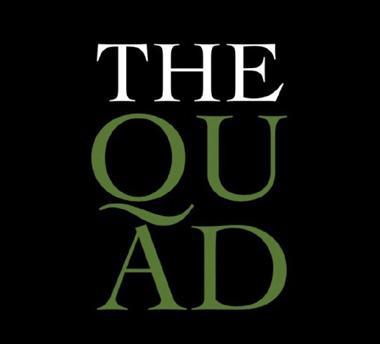
Barbara Vasquez Production Editor/Web Editor
On Thursday, Oct. 2, the second annual John L. Paluszek Scholarship was awarded to senior Agne Adomauskaite, a public health and business major. This scholarship offers $10,000 to first generation college students in the Kakos School of Arts and Sciences [KSAS], who exhibit, “exemplary community service and civil engagement,” according to manhattan.edu.
The scholarship came to fruition last year after co-chairs Mehnaz Afridi, Ph.D., and Heidi Laudien, Ph.D., initially thought of hosting a ‘KSAS gala’, which entailed inviting alumni back to campus who were interested in celebrating retiring faculty.
They reached out to alumnus John Paluszek ‘55, who then expressed interest in creating a scholarship, “to shine a light on those students who are driven to succeed academically in any of the liberal arts, realize the importance of giving back to their communities, and understand the special challenges of a first-generation college student,” according to manhattan.edu
The scholarship recipient is chosen by the John L. Paluszek Scholarship Committee, which includes Paluszek himself, Afridi and Laudien, as well as
committee members Deirdre O’Leary, Ph.D., and Brian Chalk, Ph.D. Applicants are asked to send in a short essay application with details of their recent activities, as well as signing an agreement to become an ambassador for KSAS/first generation students and participate during Accepted Students Days.
Of the entire applicant pool, Adomauskaite stood out to the committee, particularly due to her experience as a resident assistant at MU and her previous volunteer work. This, alongside her excellence in academics, impressed committee members.
Paluszek shared a statement with The Quadrangle further detailing Adomauskaite’s fit with the scholarship.
“Our family is delighted to recognize the impressive achievements and admirable ambition of an outstanding student, Agne Adomauskaite,” Paluszek wrote in an email to The Quadrangle. “Agne has excelled in academics and also in being an outstanding “good citizen’’ of MU, by undertaking co-curricular and extracurricular activities beneficial to many on campus and beyond… She is truly on a path to a meaningful life. It is a joy to assist a bit along the way.”
Outside of her application, it was Adomauskaite’s upbringing and character that pushed her to the forefront of the committee’s minds. As
Volume CXI, Issue 8
21, 2025
The Editorial Board
Grace Cardinal Editor-in-Chief
Emmanouel Sofillas Managing Editor
Laili Shahrestani Features Editor
Leyla Mercado Arts & Entertainment Editor
Barbara Vasquez
Maizy Swift Production Editors
Amy Forster Asst. Production Editor
Mary Haley Marketing Chair
Brooke Della Rocco News Editor
Mary Haley Asst. Features Editor
Andrew Mannion Sports Editor
Owen McWalters Asst. Sports Editor
Barbara Vasquez Web Editor
Maizy Swift
Elaina Batista Asst. Social Media Editors
Thom Gencarelli Faculty Advisor
About The Quadrangle

A tradition since 1924, The Quadrangle is a news organization run by the students of Manhattan University. We strive to cover news around campus and the greater community, publishing weekly in print and daily online. Our goal is always accuracy, relevancy and professionalism.
The opinions expressed in The Quadrangle are those of the individual writer and do not necessarily reflect the views of the Editorial Board, the University or the student body.
Join The Quadrangle
The Quadrangle’s staff holds weekly open meetings on Tuesdays at 4 p.m. All are welcome to come and join the club.




Dear Readers,
Hello, and welcome to Issue 8.
Freedom of speech, as it frequently has been for the past few months, has taken center stage in the news and specifically student media yet again this week. From nationwide “No Kings” protests over the weekend, including several here in New York City and the Riverdale area, to a federal lawsuit filed by The Stanford Daily, new issues are arising each day that beg to be at the forefront of our weekly discussions.
While The Quadrangle did not add its name to The Stanford Daily’s brief in an official capacity, I want to take this opportunity to shed light on this case and encourage you all to research further. In short, The Stanford Daily and “Student Press Amici” have filed to challenge the U.S. Government under Secretary of State Marco Rubio for using certain immigration laws to penalize international students who express political opinions. The 19-page brief argues that journalism is essential to democracy, that the government is unlawfully using immigration laws to freeze student speech, that the damage these practices have caused are already widespread and that the long-term consequences of these practices can, and will, be detrimental to free speech and student journalism moving forward. Ultimately, the brief calls on the court to stop the government from using these immigration laws to justify retaliation against students who speak out, and to protect First Amendment rights for all students, both U.S. citizens and international students in the country on a visa.
Although The Quadrangle doesn’t currently have any international students on staff, our mission remains the same: to be a voice for everyone on this campus. Manhattan University’s strength lies in its diversity, and that includes our community of international students. For those on campus, I implore you to use The Quadrangle as a resource to amplify your voice. We are always eager to receive and publish Letters to the Editor, OpEds and the stories that matter most to you.
As for this week’s issue, our news section covers the newest recipient of the John L. Paluszek Scholarship, MU’s most recent Senate meeting, the winners of the “Disrupt Everything and Win” campus contest hosted by the JPHP, and finally, a Manhattan Caucus focused on Thursday’s NYC mayoral debate. In features, you’ll find a Voices on the Quad from the mayoral debate watch party and Wellness Walks restarting on campus. In A&E, we cover a mural unveiling in performing arts as well as a Book Nook on “The Power and the Glory”. Lastly, in sports, we bring you an overview of men’s club soccer and Games of the Week. We hope you’ll check it all out.
Stay safe, stay curious and stay informed. We’ll be back next week with more.
Until next time,
of outside involvements, and she was just really overall an impressive candidate.”
the application, I smiled and said ‘I know exactly who this is.’”
a successful first-generation American descended from Lithuanian immigrants, she truly embodied what the scholarship recipient is meant to represent.
“Her story was touching because it really is an immigrant story, and she’s lived it,” Laudien said. “She’s just such a hard worker that her application really stood out. She truly exceeded what we were looking for in terms
O’Leary, who taught Adomauskaite in a class, was able to testify for her character from her personal experience.
“She, quite simply, is the kind of student who makes every classroom better through her presence, her sharp observations, her generous contributions in class, her ability to listen to her colleagues and then offer valuable insight and criticism,”
O’Leary said. “I only taught her once, but as soon as I saw
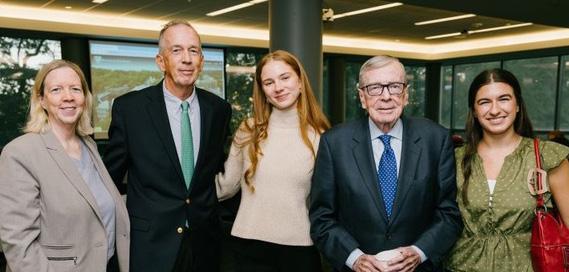
Apart from the financial stipend, committee members hope that Adomauskaite will be positively impacted by receiving this scholarship and will help nurture the evolution of it for future recipients.
“I have every confidence that this will continue to be meaningful to her,” Chalk said. “ I hope that the way in which education can have a wonderful effect on an individual’s life will be something that she’ll look back on after she’s graduated, and she’ll still be invested in looking after students like herself in similar situations.”
Chalk continued, praising Paluszek’s generosity in establishing the scholarship in the first place, and hoping that the same sentiment gets passed down to recipients to come.
“John Paluszek has gone out into the world and become remarkably successful, but there’s still something about this place (MU) that represents a part of him that he wants to
pass down,” Chalk said. “We’re hoping that Agne feels the same, and that all the winners of the scholarship feel the same way, and that this place will continue to matter to them.”
As the scholarship continues to grow past its second year, the committee hopes it evolves more and more with each winner. According to
a post from Adomauskaite’s LinkedIn account, she shares the same hopes.
“I can’t wait to witness Mr. Paluszek’s award bring together a network of firstgeneration college students who have overcome countless silent obstacles, and I’m deeply honored to be part of its start,” Adomauskaite wrote.

CONTINUED FROM PAGE 1
or reserve an entire side of a four-person suite in Horan Hall,” Lowe said.
The arrangement of the rooms in Chrysostom Hall and Jasper Hall that obligates students to use communal bathrooms was addressed, and now students have the option to be in single rooms with private bathrooms, while only sharing with two other suites. Lowe also shared that meal swipes at Café 1853 have been introduced.
There was a focus to make the first six weeks of the semester as successful as possible for incoming students. Lowe proposed executing one program every night for the first six weeks in the residence halls.
This goal was exceeded, with 52 programs taking place.
Lowe also shared the importance of getting more students to go to sports events, hoping to achieve a good turnout for Manhattan Madness, the university’s annual pep rally.
“We are working on better game day signage,” Lowe said. “We will organize some tailgates. We gather feedback from students, also from other institutions, and those who attend consistently on what they want to see. We will have events hosted by men’s basketball and women’s basketball throughout the season, and just an overall increased awareness on when our games [are].”
As for Public Safety, the team reported recruiting more local businesses to
join Jasper Safe. The office also reported the purchase of one hundred safety locks that are set to be installed in classrooms to aid in case of emergencies.
Additionally, the block schedule for fall 2026 will be voted on Nov. 4. This schedule has been researched for 18 months and the Senate hopes to enforce it beginning January 2026.
Chalk mentioned discussions about a new mandatory attendance-taking policy and double-dipping policy.
“[The double dipping policy would] limit the amount of courses that could count to two majors to basically a sliding scale based on the number of credits required,” Chalk said. “Two courses for majors up to a certain number
of credits, and then three courses, if the major exceeds that number of credits.”
Neither of these new policies have been officially voted on as of yet.
Berg went on to introduce a new joint senate/student government committee.
“[The purpose of the committee is] to strengthen collaboration, communication, and coordination between the Student Senate and the Student Government Association (SGA) in serving the student body,” Berg said.
Berg mentioned how students were unaware of these organizations as avenues for them to voice their concerns and wanted to bridge the communication gap between them.
This act was approved by the Senate, only needing
the approval of the assembly members from the SGA to move forward.
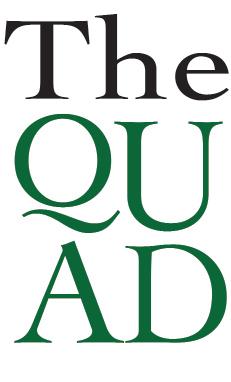
Sarah Rolka Staff Writer
On Oct. 9, winners for the “Disrupt Everything and Win” Contest were announced on the James Patterson Honors Program’s (JPHP) Instagram page. The contest allowed both students and staff to be “positive disruptors,” and to come up with a pitch that would fix a certain issue on campus.
First place winners receive the chance to implement their pitch on campus.
First place student winners included Vannesa DiPilato, Seamus Bryne and Paul Harrison with their pitch “Jasper Reset Room.” Second place went to Aine Kolpa with “The Cozy Campus Initiative: Transforming Thomas Hall into a True Community Space.”
Third place had a tie between groups including Diya Patel and Brody Cox with a “Patterson Repurpose Club” and David Pozo with an “Interdisciplinary Collaboration Lab: Student-Led Cross-Major Teams Solving Real Campus Challenges.”
The winning group included DiPilato, senior mechanical engineering major, Bryne, junior mechanical engineering major and Harrison, junior
electrical engineering major, who all spoke to The Quadrangle about their group’s pitch and the rationale behind it.
“We did mental health and awareness, so for our final pitch, we decided to make something called the Jasper Reset Room,” DiPilato said. “The idea of the Jasper Reset Room is that we wanted to have a space for residents on campus, starting with Lee Hall. It’ll be for people, whether they’re homesick, they just need a quiet moment away from their roommates or they’re going through something and they need some alone time…just to destress, get their emotions out in a safe way. A lot of freshmen we’ve noticed, they don’t really have a space to themselves. You’re not used to living somewhere different [so] you may not be used to sharing a space with other people. That can be stressful. This room is to have a quiet moment for yourself to regulate how you’re feeling.”
The group also mentioned what sparked their project idea.
“We were in the library one night, and I saw the email about it [the contest],” Bryne said. “So, then we spent around an hour and a half brainstorming ideas and since we’re RAs, we
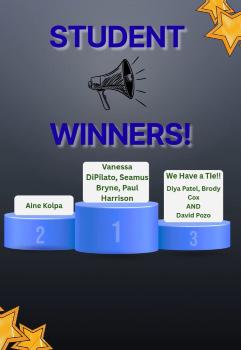
knew something had to be done for the freshman dorms.”
The group mentioned that it felt surreal to win the campus-wide contest, and expressed their gratitude for the opportunity.
The winners of the staff contest included Deidre O’Leary, Ph.D. and Heidi Laudien, Ph.D., English professors. O’Leary and Laudien wrote in a statement to The Quadrangle about the group’s pitch and what they hope to accomplish with it.
“We pitched a free shop on campus open to all students and employees at MU,” O’Leary and Laudien wrote in an email to The Quadrangle. “Students moving out of the dorms will donate any gently used, no longer needed dorm decor and furniture. Collections will be made on move out day. The Redorm shop will be up and running for the fall of 2026.
The average college student disposes of approximately 600 lbs of goods per academic year. Our aim was to salvage items and rehouse or “redorm” them.
We hope that this initiative will contribute to the culture of sustainability on campus and disrupt notions of resource sharing and consumption. Don’t throw out your junk,
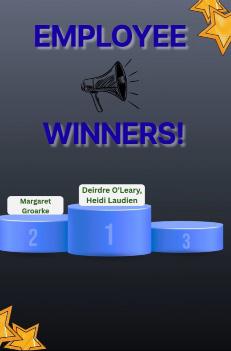

redorm it!”
The contest was introduced prior to the “Disrupt Everything and Win” book event on Sept. 29 featuring James Patterson ‘69, and Patrick Leddin, Ph.D. At the event, the two spoke about their recent book together: “Disrupt Everything—and Win.”
Ana McCabe, program manager for JPHP, also spoke to The Quadrangle on the topic of picking the winners.
“There was myself and two other judges who are both faculty, two deans, Dean Kelly [of KSAS] and the associate dean of the O’Malley School of Business [Grishma Shah],” McCabe said. “All three of us read through each submission and followed the rubric [created by Saracino]...It was a very hard decision since there were a lot of great submissions.”
McCabe continued on to explain that they wanted the selected plans to benefit everyone in the campus community, from residents to commuters, students, staff and faculty.
“We wanted to make sure they (the winning idea) benefitted both students who reside on campus and the commuters,” McCabe said. “So to try to create more programs that can include everyone is something that we’re really trying to strive for when creating different programs, events, or activities.”
Michele Saracino, Ph.D., is
the executive director of JPHP. She spoke to The Quadrangle about the creation of the contest and the “drivers” behind it.
“First of all, there was James Patterson coming back with his co-author, Patrick Leddin, for the book,” Saracino said. “That is supposed to really enliven someone to take a moment of change or disruption and turn it into something positive. Also the Honors program, when Mr. Patterson and I were talking about it, he wanted students to get involved in contests on campus.”
An interactive contest like this one has the possibility to shape the population of Manhattan University in a ‘positive’ way. Saracino commented on this, explaining that there’s a true passion that comes with investing in the culture at MU.
“I think it brought a little needed excitement, we got more [submissions] than what we expected,” Saracino said. “They were fun, exciting, [and] they were engaging. It shapes the culture of MU because everyone here, whether you’re a student or an employee, has a level of investment. People become more invested when they think about how they can make something better, then they develop a plan. There’s passion behind that, and then you need the perseverance to see it through.”
Elaina Batista & Zendrah Bonnick
Asst. Social Media Editor & Staff Writer
On Thursday, Oct. 16, three of the leading candidates for the New York City mayoral election took the stage at Rockefeller Center to debate some of the most pressing issues facing New Yorkers.
Zohran Mamdani spoke as the democratic nominee, Andrew Cuomo as the independent nominee and Curtis Sliwa, the founder of the Guardian Angels, as the Republican nominee.
The debate lasted for two hours and each candidate was given one minute to respond to questions and 30 seconds for rebuttals. This was the first general election debate between Mamdani, Cuomo and Silwa.
The candidates disagreed on a number of local and global issues, including how they would deal with the Trump administration and the recent ceasefire agreement in Gaza, as well as concerns like crime, policing, affordability, housing and transit.
The debate began with the candidates being asked why they believe that voters should trust them or whether they are qualified to be mayor. Andrew
Cuomo responded by stating, “I got government to work… This is no job for on the job training.”
Cuomo initially entered the race as a Democrat, but after losing the party’s nomination and Mayor Eric Adams withdrawing from his reelection bid, Cuomo switched to run as an independent.
Mamdani was then asked how he was prepared to lead New York City given his lack of executive experience. He responded by noting that he has served in the New York State Assembly for five years and outlined his priorities, including advocating for the working class and increasing funding for public schools. He concluded by saying, “I have the experience of being a New Yorker, someone who actually paid rent in this city before I ran for mayor.”
In response to the same question, Silwa stated how he does not declare himself to be all knowing.
“I will hire the very brightest and best in their fields who have dedicated their lives to trying to improve the city of New York…but what I will say is thank God I’m not a professional politician,” Silwa said in the debate.
Throughout the debate, President Donald Trump and the extent of his authority were repeatedly mentioned, along
with how his influence could affect the city. According to Cuomo, Trump would depose Mamdani and weaken his position.
When addressing the topic of cost of living/affordability, more specifically rent in New York, Mamdani says that he plans to freeze the rent for more than two million rent stabilized tenants and build over 200,000 “truly affordable” homes across the five boroughs to ensure people in New York have more housing.
An intended consequence of this would be a reduction in the number of people priced out of housing in the city. Cuomo attacked Mamadai’s plan to freeze rent and claimed it does nothing for homeowners or people who are being priced out, emphasizing that rent stabilized apartments should be reserved for the “most rent burdened.”
When Silwa was asked to describe his plan to help renters, he stated that his whole
goal is to, “improve not remove,” and that in order to keep New Yorkers in the city, property tax needs to be cut.
A central piece of Mamdani’s campaign is the idea of free buses for all. In the debate, he elaborated that his plan to make this possible if elected is, “replacing the revenue that the MTA currently gets from buses, revenue that is around 700 million dollars… making buses free does not only provide economic relief but also public safety.”
Mamdani claimed this plan will be executed by raising the taxes on the top 1% of New Yorkers by 2%, which would raise four billion dollars, in addition to also raising the state’s top corporate tax rate, which would raise five billion dollars.
Both Cuomo and Silwa disagree with Mamdani’s free bus proposal and believe that the rate of fare evasion is already too high. However, Cuomo slightly diverged from Silwa who was opposed to the implementation
of free public transportation, instead proposing free subways and buses for working families.
According to a poll conducted by Siena University and The New York Times, Mamdani is up by 56%, Cuomo at 24% and Silwa at 15%.
At its conclusion, the debate demonstrated that each candidate has a distinct vision for the city’s future. From rent policy and transit finance to public safety and national politics, Mamdani, Cuomo and Sliwa presented opposing goals and governing styles. While their policies frequently conflicted, the debate provided voters with a better understanding of how each candidate would address frequently discussed issues of affordability, transportation, local administration and managing federal interference. the way, and Jae’s journey exemplifies this resilient approach perfectly.”


Laili Shahrestani
Features Editor
On the evening of Oct. 16, a mayoral election debate watch party was held on the first floor of Kelly Commons. Students and faculty members gathered to observe the New York City mayoral candidates – Andrew Cuomo, Zohran Mamdani and Curtis Sliwa – as they debated on live television. The event served as a place for individuals to gain better insight on each candidate, discuss their thoughts with peers in a respectful manner and potentially even make up their mind on who they want to vote for, as New York City will officially elect its next mayor on Nov. 4 - less than a month away. The Quadrangle spoke with a number of Jaspers in regards to their thoughts on the event, and what they got out of it.
Seamus Byrne ‘27, mechanical engineering major
The Quadrangle: Why do you think it’s important for students to pay attention to local elections like this?
Seamus Byrne: We’re such a heavy commuter school and a lot of people already live in New York City or in the surrounding areas, so their lives are directly affected with the political state of the city
and who’s running it. So if the “wrong” person is elected, then for however many years that’s going to be an issue. Like, people might not be able to get as good of transportation, or whatever it may be.
TQ: What does it feel like to watch a mayoral debate while living in the city it’s about?
SB: Honestly, it’s interesting just because of how it will affect our lives going forward. Like, you don’t know what your future holds, and the candidates do determine a big part of it.
TQ: How does watching together with other students change the experience compared to watching alone?
SB: For me, I’m not too knowledgeable about politics, so if I have any questions, I know I can ask someone who’s more knowledgeable to help me understand.
TQ: What is one key takeaway from the debate or something you were looking forward to learning?
SB: I want to learn more about both candidates. I’m not super political, so I want to know more about them before forming an opinion.
Lucas Haas ‘26, environmental studies
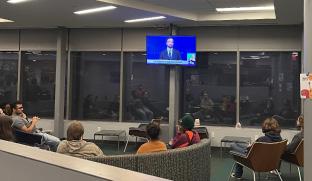
living in the city it’s about?
The Quadrangle: Why do you think it’s important for students to pay attention to local elections like this?
Lucas Haas: I think it’s important for us to pay attention to this because we are going to school here for at least a couple years at a time. It’s good to see who’s going to be leading the city in the future, and to at least try and have something on our minds. Even if someone can’t vote, they could at least speak their voice publicly and whatnot.
TQ: What does it feel like to watch a mayoral debate while

LH: I guess you can say surreal, because we can see and hear about all the issues that they’re talking about and it’s more impactful on us here. It’s not a presidential debate where some of the issues are larger and broader and not so much affected. It’s definitely stuff that you hear about and see all the time.
TQ: How does watching together with other students change the experience compared to watching alone?
LH: In a group, you get to hear everyone’s reactions, and laugh at all the crazy comments. But also, you get to talk about it together and kind of respect what the candidates are saying.
TQ: What is one key takeaway from the debate or something you were looking forward to learning?
LH: One thing I’ve learned is that I still have not made up my mind. If I were to vote, I don’t know who I would vote for yet. I’m definitely learning more about themselves, like as candidates, because I haven’t really seen any of them in debates yet.
Lindsay Quintanilla ‘29, political science major
The Quadrangle: Why do you think it’s important for students to pay attention to local elections like this?
Lindsay Quintanilla: I think it’s important because students need to educate themselves in order to vote correctly about what they believe. You also don’t want to like someone that isn’t going to be good for the city, right? Just listening to it helps you make sure you stay educated.
TQ: What does it feel like to watch a mayoral debate while living in the city it’s about?
LQ: I find it interesting. I’m thinking about what’s going to happen next, who’s going to get elected and how this is going to change the city for the good or for the bad.
TQ: How does watching together with other students change the experience compared to watching alone?
LQ: I like watching people’s reactions. I feel like it makes it more interesting, especially when seeing how other people are interested in it as well.
TQ: What is one key takeaway from the debate or something you were looking forward to learning?
LQ: Just anything more in general. I do not know too much about the election, which I should because I’m here now, but I’m originally from Atlanta. So yeah, I just want to learn more about everything.
Zeke Jazwinski Staff Writer
College students are known to supposedly be some of the most stressed people in the world. Luckily, at Manhattan University, there’s a program that can help. Thanks to Exercise is Medicine On Campus (EIC-OM), part of the Department of Kinesiology and Health, student life and health services, MU has started to once again host their weekly wellness walks.
Jeff Cherubini, Ph.D., professor of kinesiology and a member of the EIM-OC leadership team, wrote to The Quadrangle in regards to what wellness walks are all about.
“We have organized and are hosting weekly wellness walking groups, with the goal of improving health and building community on the Manhattan University campus through movement and conversation,” Cherubini wrote. “The walks also connect to our Lasallian tradition of educating the whole person, benefiting physical, social, emotional and even spiritual health.”
Cherubini mentioned more about some of the benefits these walks could have for
college students.
“In addition to the actual walking and physical activity, another advantage of the walk is the idea of enhancing our ‘sense of community’ on campus via getting all outside together, walking and talking,” Cherubini wrote. “With a sort of sub-theme to our walks of ‘building community through movement and conversation’, as mentioned above, we are hoping for much more than just a physical benefit to the walks.”
From a student’s perspective, Catherine Edison, a physical education major and a member of the EIMOC leadership team, wrote to The Quadrangle about the advantages of participating in the wellness walk.
“Some advantages of our wellness program are exercise and movement for students and faculty,” Edison wrote. “Movement is great for improving mental health as well as physical health. It also is a great way to meet other students on campus and take a break from school work.”
All of these benefits highlight why wellness walks are more than just a nice break, they’re an essential part of maintaining balance in college life. When students take time to move, breathe and connect

with others, they’re not only improving their physical health, but also actively reducing anxiety and burnout. In an academic environment like college, stress can build up and lead to decreased focus, poor sleep and weakened health.
Cherubini explained further to The Quadrangle why he thinks wellness walks specifically are important to have implemented.
“Movement for movement’s sake is important (in terms of the physical benefits), but even more so, as part of the walks is feeling better mentally and feeling more connected socially - all of which can occur during and after just one walk,” Cherubini wrote. “It’s this immediate positive effect (in terms of ‘feel good’ emotions), that we are hoping students, staff and faculty can walk away with.”
Regular wellness walks encourage students to step away from screens, spend time outdoors and engage in real conversations. These are all proven ways to improve mood and productivity. By prioritizing wellness, Manhattan University is showing that mental health and community care are just as important as academic success.
Catherine Edison wrote to The Quadrangle on why she wants students to attend the walks.
“I want students to have options for movement,” Edison said. “We have a gym and club sports teams, but sometimes those can feel daunting. A walk is something that everyone can do to take a break during their day and move.”
Edison also went on to write about what alternatives there are for students who can not attend the walks.
“We are currently working towards implementing stretching classes and pickleball days,” Edison wrote. “If students can’t make the walks but are interested they can ask for a Jasperfit Mentor - a kinesiology student who can help create a movement plan for anyone. Any movement

The weekly wellness walks begin on the steps of Squeri Hall.
MANHATTAN UNIVERSITY PHOTO SHELTER / COURTESY
a student can do is highly encouraged!”
As wellness walks continue to grow on campus, their impact has the potential to reach far beyond just a weekly activity.
In an article published by the National Library of Medicine, associate professor of biochemistry and physiology at the University of Oklahoma, Zoltán Ungvári, Ph.D., wrote about the scientific-based research benefits behind walking.
“Walking decreases the risk or severity of various health outcomes such as cardiovascular and cerebrovascular diseases, type two diabetes, mellitus, cognitive impairment and dementia, while also improving mental well-being, sleep and longevity,” according to the article.
Wellness walks can be a
simple and beneficial way to cater to the body and mind. Small steps, both literally and figuratively, can lead to a healthier and more supportive campus environment for everyone.
If you’re interested in joining the wellness walks, Cherubini wrote about how to attend.
“There is no sign up needed or any type of RSVP,” Cherubini wrote. “Mondays at 4:30 p.m. and/or Wednesdays at 12:15 p.m. with all students, staff and faculty welcome to join in! So it’s a matter of just showing up to the Smith/Squeri steps ready to walk on those days and times you may be free. And honestly, no agenda to the walks except fresh air and community building, plus the added bonus of physical activity.”
Maizy Swift and Zendrah Bonnick
Production Editor/Asst. Social Media Editor and Staff Writer
On the evening of Friday, Oct. 17, students, staff, faculty and friends gathered in room 5.17 of Thomas Hall, to attend the opening of the Manhattan University Performing Arts’ Mural. The mural was designed by Madison Hackett ‘25, who majored in digital media arts, and minored in business, who was also in attendance for the unveiling.
The mural portrays various groundbreaking musicians, including Billie Holiday, a swing vocalist and civil rights advocate, alongside Chuck Berry, Frank Sinatra, Duke Ellington, Miles Davis and John Coltrane, ending with bass player Charles Mingus.
Hackett discussed her inspiration and creative process behind the piece.
“The Manhattan University Jazz Band actually really inspired me to paint this mural, because I figured they had this giant blank wall and I thought it would be really great to add some lively color to it,” Hackett said. “And what better way to do that than to make it very musical? So I painted some of
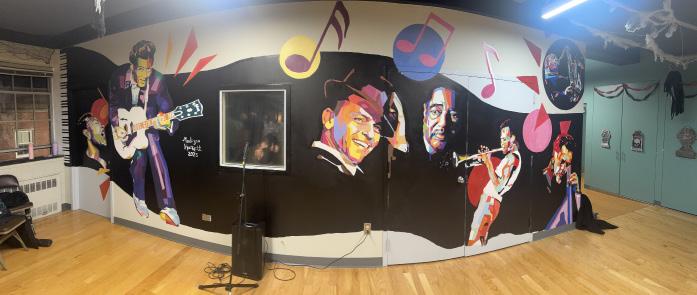
the greatest musicians in early American music.”
Hackett only had limited time to complete the painting.
“I only had three months to physically do it, originally we had to provide funding,” Hackett said. “It was Dr. Pottinger who provided the funding, he worked really hard for it.”
Hackett further described the process in designing the mural.
“I made a mockup digitally using Photoshop, I sketched out my idea, [and] played around with all the colors,” Hackett said. “I painted the piano, and then I started to go
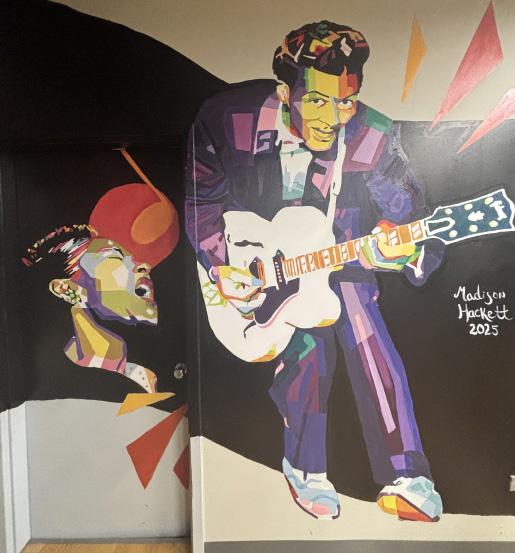
inside and paint the details. I started with Billie Holiday and ended with Billie Holiday because I jumped around a lot.”
Overall, Hackett hopes that this mural will serve as encouragement to students at MU to follow their own dreams and ideas.
“I just really hope that they get inspired and they know they have a voice and whatever they want to do in college they definitely can make it happen,” Hackett said. “I was just a student and I had an idea and then I acted on it and I brought it into fruition, and I’m happy and proud of that.”
In attendance at the event was Vanessa Goncalves, a senior performing arts scholarship recipient. Goncalves is a participant in the campus Music Ministry and co-president of Singers. Goncalves explained the importance of the mural to her as a performing arts student.
“I think as a senior it just makes me very proud of the place that I spend so much of my time in, I feel very proud of her and I feel very proud of the legacy that she’s making,” Goncalves said. “I can imagine the excitement that they’ll [visitors] see if they walk into that space and they’ll take a look at it. I’m very excited because that will be remembered for everyone whoever comes in this room ever again.”
Amaya Castillo-Mills, a junior sound studies major at MU, performed at the event and shared how the mural can
relate to all students and people who enjoy music.
“There’s rock, classic rock and roll, blues, jazz, there’s influences that would influence pop music today,” Mills said. “I think it’s important for everybody to just stop by and peer at it just a little bit, there’s something for everybody on the wall.”
At the unveiling, MU’s Players performed the song “Rainbow Connection” in efforts to promote their Muppetsinspired cabaret.
Grace Coutu, a junior majoring in early childhood education, performed at the event as a member of Players. Coutu felt the mural was a great representation for performing arts students at MU.
“I really like Frank Sinatra, I like Billie, so it’s a lot of good artists, a lot of artists that have had really big impacts on music as a whole, and the history of music and how people take advantage and change music over time,” Coutu said.

Marc Veldhuyzen Contributor
Do you hate yourself?
Hopefully, no, and statistically the majority of the people reading this don’t. However, there always exists in every community the lowest experiences of human existence. You’re not alone, if your dice happened to land
there. It’s not your fault either.
One of the hard lessons of the school of life is that control is limited and often illusionary, despite how desperately we are to resist fervently against that fact.
It is in this place that we find the priest in The Power and The Glory, by Graham Greene.
A destitute and broken man.
A man of shattered ambition.
A man at his lowest point. He is disgusted with himself.

How could he not be? He is a criminal. The government, fed up with the catholic churches abuses over Mexico, has outlawed it and in the Southern provinces in which he lives, the punishment is death. From the outset this priest seems to be a hero, he is standing up for his beliefs, resisting a tyrannical government, a paragon of christian martyrdom.
But he also has a child. He is a whiskey priest, an alcoholic. His thoughts, before the repression, were more on ambition to rise to being a Bishop, not on his local community. All of those ambitions are gone now, of course, but they still haunt him. Like a little nudge, a little reminder of how evil and terrible of a human being he truly is. He is absolutely certain of his fate after death. He could feel the fires of hell brushing against his skin. Every negative trait of the priest is emphasized and laid out in its raw fullness. He has grown obsessed with it. He spends nearly every second of every day with that weight of self-judgement dragging itself around. If you looked only at his own thoughts then you’d be sure that he is right, he is evil.
The problem, as it always is when it comes to how you perceive yourself, is the other. Being the only priest in that province of heavily religious southern Mexico, the believers he encounters on his aimless journey are infatuated by him. They see him as the last vestige of resistance, proof that hope still lives. He continues to keep going out of a very real and genuine desire to save souls and help people, something he devalues as much as he can, and yet still exists. In his suffering, he experiences his fellow Christians in a way he never could as a wealthy priest. He wears their same
clothes, he eats their same food, he looks poor and ragged. Despite how much he hates himself, the people around him see value in him. He dismisses their claims, but really, he is a figure of respect. It’s very silly, in hindsight, how much he hates himself.
This is especially true when he is contrasted by the Lieutenant. The Lieutenant doesn’t hate himself. He is a happy and very mentally secure man. He is not very self-critical at all. He is also a complete and utter monster. The man tasked with killing the priest, he exists as a reflection of what the priest was before his suffering. An ambitious and secure man who rides around on a horse, utterly different then the people he serves, yet still claims to be the people’s highest servant. While the priest feels the immense mental guilt at having fallen into the sin of sex a single time, the Lieutenant without batting an eye orders a man from every village to be shot, until they turn in where the priest is hiding.
In the end, the priest is found and the priest is shot. He makes
it across the border into a safer place, but returns back for the mere chance to save one soul, an American, who was murdered and robbed and then fled to Mexico. His last moments were not pleasant. There was no sudden revelation. Instead he was numb to it, his greatest fear being the pain of the bullets striking his body and then hell to come after. He never realized he was a good man.
It is, in a sense, a very classic Christian story. He may not have realized it, but, through his suffering he ended up embodying the tenets of Christ which he thought he strayed so far from. All of this happens while the Lieutenant, the one which his world gave success and power, is on the opposite end. It doesn’t matter if you think you’re perfect or if you think you’re disgusting, both points of views probably stem from delusion. This story shows that you have traits some consider good and some consider bad, and you can move yourself through that. You are not an absolute object of hatred or love. You are you.
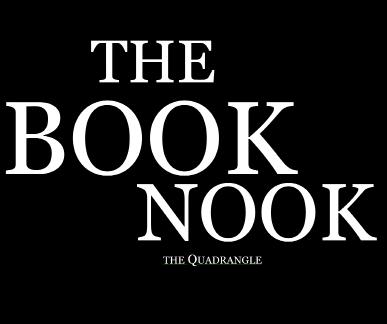
Maizy Swift
Production Editor/Asst. Social Media Editor
Club soccer at Manhattan University has officially started their season. Club soccer is one of the newest club sports additions at MU, and so far has proven themselves as a success.
When speaking about the season and their recent accomplishments, freshman Shane Diley, an education major and player on the team, wrote to The Quadrangle about the team’s winning record.
“[The season is] Very good so far, with a winning record in our first ever season we passed most expectations of the players and the other teams,” Diley wrote. “We have gone from a school with intramural soccer to a soon to be national contender in club soccer within a year, with more to come.”
Diley also shared how
teamwork and community plays a large role in the experience he’s had on the team.
“The team has built such a supportive and good community, with practices most days of the week, most players end up staying 1-2 hours after practice ends just to hangout and socialize as a group,” Diley said. “I think our large group of international students bring a unique feature to our team as we are bonding and learning how to build chemistry with each other. On top of this, the large range of ages from freshman in their first semester, to graduate students approaching their last semester at Manhattan, helps players create good networks and connections within the team.”
Another player, junior Malcolm Naughton, another childhood education major, shared how his experience this season has been.
“The season has been great so far, we started it off with a great win against Iona and set

The MU men’s club soccer team at their first practice back in September.

the standard for the type of team we want to be,” Naughton wrote to The Quadrangle. “The players are committed to the team and we’re all excited to be playing fun competitive soccer again. We’ve bonded really quickly as a team and have learned to play together but we still have stuff to learn and a lot of space and talent to grow.”
Naughton has enjoyed connecting with his teammates through their love of soccer and their ambitious attitude.
“The team has built a great community really quickly, we’ve had a lot of practices together and we all share a love of soccer, we all play well together because we want to win,” Naughton wrote. “I’ve wanted a club soccer team on campus since I was a freshman so having this team has had a really positive impact on my time here at Manhattan, being on a team that practices weekly and competes against other schools has been really fulfilling we have a great group of guys and I’m excited to see how the team grows.”
Sophomore Ryan Hayes, a civil engineering major, shared
what he’s looking forward to for this upcoming season.
“[The] Season is going pretty good, we’re winning games, got a good squad behind us, like to see us at practice, nice to get some rigidity to the program,” Hayes wrote. “The only thing holding us back is teams to play and funding I think.”

Barbara Vasquez
Production / Web Editor
On Oct. 11, the Manhattan University’s men’s soccer team secured a conference victory against Mount Saint Mary’s University in a game of 3-0 for the Jaspers. Sophomore midfielder William Fagerberg continued his stellar season, posting all three goals in the game for the first hat trick of his career.
The first period of the game was busy for the Jaspers, with eight shots attempted throughout compared to the Mountaineers four. Fagerberg connected his first shot in the 16th minute of the game with assists from freshman midfielder Giovanni Rivera and freshman forward Martin Rodriguez. The second half of the game began with more action led by Fagerberg making a goal within the first two minutes back on the field, once again assisted by Rodriguez and sophomore defender Max Asplin-Rowley. The Mountaineers were quick to respond, making three attempts at the net soon after. Senior goalkeeper Ludvig Malberg blocked all attempts, totaling six saves throughout the entirety of the match. In the 84th minute, Fagerberg secured his third goal, ending the game on a high note for the Jaspers. Fagerberg and Malberg were recognized as MAAC offensive and defensive players of the week following this match, respectively.
Unfortunately, men’s
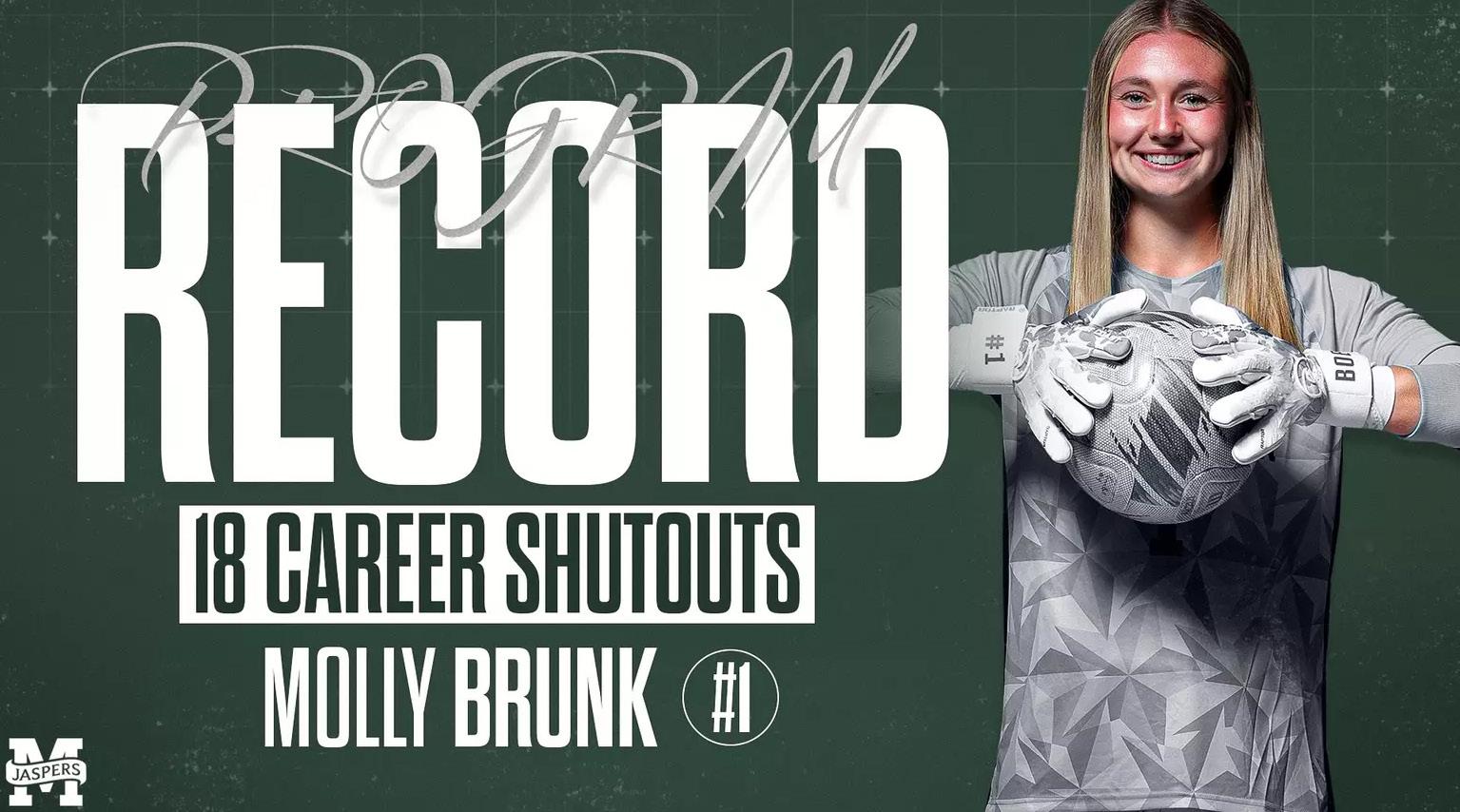
Brunk
soccer ended their two-game winning streak with a loss against Quinnipiac University this past Wednesday. The Jaspers played offensively in the first period, taking nine shots against the Bobcats to no avail. Quinnipiac attempted one shot against MU, saved by Malberg.
The second period of the game amped things up with Fagerberg connecting a goal within the first six minutes, assisted by Rodriguez. The Bobcats evened the score just three minutes later, successfully making their own goal and tying the game. The next half hour of game time
was a back and forth between the two teams, with shots taken from both sides until the 85th minute where Quinnipiac secured the final goal of the game, ending the match with a score of 2-1 in the Bobcats’ favor.
The Jaspers next face off against conference competitor Fairfield University, ranked fourth in MAAC standings currently compared to MU’s sixth place ranking.
Women’s Soccer
MU’s women’s soccer team had a productive game against the Marist University Red Foxes this past Wednesday,

Oct. 15. The Jaspers started off strong in the first period, taking shots early on and continuing to act offensively consistently throughout the first half.
Senior goalkeeper Molly Brunk was called to action quickly, blocking a goal attempt from Marist six minutes into the period. Later on in the 28th minute Brunk made an impressive play, saving back to back shots from the Red Foxes taken just nine seconds apart.
The second period of the game saw more action in the latter half, when five consecutive shots were taken within five minutes by the Jaspers from the 75th to 80th minute. An attempt by senior defender Mayah Wheeler finally connected with five minutes left in the game, assisted by junior Amaya Hill, bringing the score to 1-0 in
favor of MU. Brunk blocked a final shot taken by Marist with two minutes left in the match, officially securing the victory for the Jaspers.
This game marked the 18th career shutout for Brunk, making MU women’s soccer history as the player with the most career shutouts. She broke the previous record of 17 held by alumnus Kristen Skonieczny, and with more games left in the season, might set the record even higher. Brunk had previously achieved the record for most shutouts in a season during her 2024 campaign as well, producing 10 shutouts during that year.
Following this game, the Jaspers are tied with Marist for fourth place in the current MAAC standings. They next face off against Fairfield University, ranked first place in conference.
